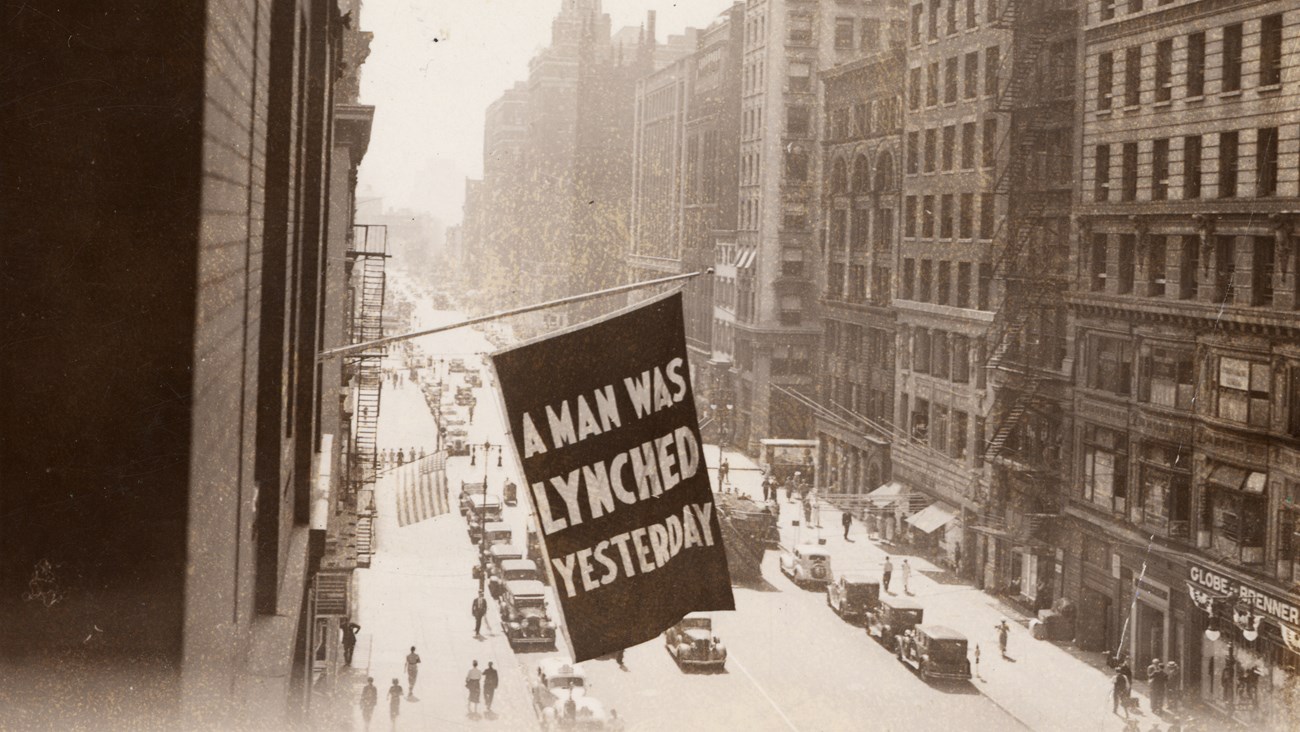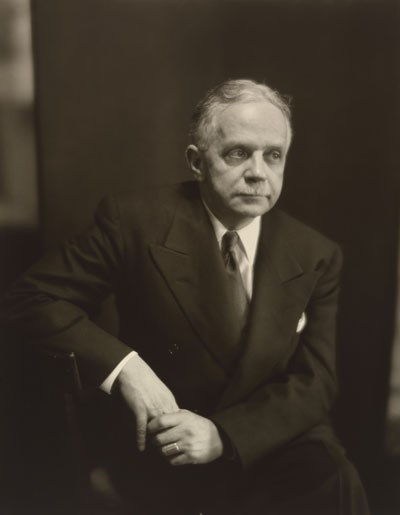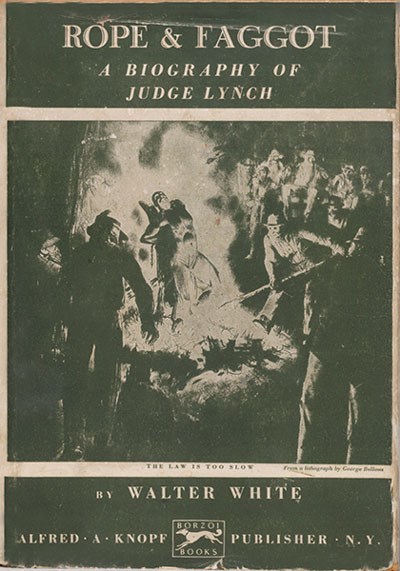
Flag, announcing lynching, flown from the window of the NAACP headquarters on 69 Fifth Ave., New York City, 1936. Library of Congress photo. “I have investigated some 41 lynchings and eight race riots and thought I was almost immune to these tortures, but this case has made me more ill and disheartened than any of the lynchings which have occurred in my memory.”
On October 27, 1934, the National Association for the Advancement of Colored People (NAACP) flew a large flag from the window of its Fifth Avenue headquarters in New York City. It bore a stark but simple message: “A MAN WAS LYNCHED YESTERDAY.” Claude Neal was just one of more than four thousand Black Americans lynched in the United States between the late 1870s and the 1950s. Walter White, leader of the NAACP, had been building the case for federal legislation for most of his adult life. While he did not live to see the passage of the 1964 Civil Rights Act and 1965 Voting Rights Act, his work on anti-lynching legislation helped lay the groundwork for both. Twelve years before Claude Neal’s murder, the Dyer anti-lynching bill of 1922 had failed to pass in the Senate, the result of a southern Democratic filibuster. In the years that followed, 180 more Black Americans had been lynched. In 1934, White prevailed upon Democratic senators Robert Wagner of New York and Edward Costigan of Colorado to introduce a new anti-lynching bill. The Costigan-Wagner bill would impose fines on counties where lynchings took place, and empowered the federal government to intervene when county or state officials failed to maintain law and order. 
Walter Francis White by Clara Sipprell. Smithsonian National Portrait Gallery. White personally believed that a successful nationwide crusade against lynching was needed as a precondition for achieving all other civil rights. He had published a searing indictment of lynching in his book, Rope and Faggot: A Biography of Judge Lynch (1929), which marshaled statistical evidence to debunk the argument that lynching was a way of punishing Black men for raping white women. In reality, he argued, the fury and sadism of white mobs was a means of social and economic control: it kept African Americans in their assigned “place” in the Jim Crow South. Anticipating fierce opposition from southern Democrats to the bill, White knew he’d have to persuade the Southern congressional delegation and President Roosevelt to back the bill. White’s relationship with Eleanor Roosevelt became crucially important. No one had greater access to the president than the first lady. In her first year in the White House, ER had failed in her efforts to include African Americans along with struggling white families in the experimental Homestead Colony she helped establish in Arthurdale, West Virginia. Bruised by this experience, in January 1934 she invited several Black leaders, including White, to the White House to advise her on race matters. That same year ER joined the NAACP and, most importantly, she embraced the NAACP’s pursuit of a federal anti-lynching law as a moral cause. ER invited White for tea at the White House and used the informal get-together as a cover for him to make a personal appeal to the president. While there were no major breakthroughs, the meeting ended congenially, giving White some measure of hope. The influential Black newspaper Chicago Defender reported on the meeting under the headline: PRESIDENT TALKS HOUR ON ANTI-LYNCHING BILL; Looking back on the White House meeting White would recall that FDR ended their conversation with a stark assessment of the political dilemma he faced at a time when southern votes in Congress meant life or death for his New Deal programs. By June, with the southern filibuster locked in place, Costigan and Wagner accepted their bill’s defeat. It would have to be resubmitted the following year. In this new legislative effort against lynching, southern Democrats again slammed the door with another filibuster and Senator Costigan pulled the bill. In protest, White denounced FDR for failing to join the majority of Americans in supporting the anti-lynching bill. 
White's searing indictment of lynching in his book, Rope and Faggot: A Biography of Judge Lynch, 1929. The truth was that FDR abhorred the inhumanity of lynching and worried about its consequences for the sanctity of the rule of law, so vital to the integrity, confidence, and workings of the nation’s democratic institutions. On January 2, 1936, President Roosevelt tried to melt the ice a bit by meeting with White for a second time. FDR proposed a half-measure. Rather than reviving the Costigan-Wagner bill once more, the Justice Department would conduct its own investigations of lynching crimes. White appreciated the president’s offer but had deep reservations. Still, White backed FDR’s bid for a second term that year, and when he won in a landslide, White incorporated FDR’s suggestion into a third federal anti-lynching effort in 1937. Change appeared to be on the horizon when, on April 16, 1937, the Gavagan anti-lynching bill passed the House by a vote of 277-120. That same day, there was another gruesome lynching. Two Black prisoners in Duck Hill, Mississippi, were sprung from their jail cells with the collusion of the local sheriff, tortured and burned to death. Yet no one was charged. With this shocking crime in the air, the Gavagan bill moved to the Senate, only to be filibustered. The Senate co-sponsors of the anti-lynching bill, Wagner (again) of New York and Van Nuys of Indiana, then delayed again until early 1938. By then, White’s efforts would see him become the first African American to grace the cover of Time magazine (January 24, 1938, issue). But, as before, filibusters in 1938, 1939 and 1940, unraveled every new anti-lynching bill that was introduced. White could not overcome the power of southern Democrats. The filibuster rule gave a small minority of senators near-limitless powers to delay or prevent any civil rights measures. A master strategist, FDR also was a political realist unwilling to jeopardize the New Deal by provoking southern Democrats. However, it can be fairly said that the anti-lynching campaign helped awaken—even radicalize—Eleanor Roosevelt to the cause of racial injustice. It was World War II that transformed the trajectory of the long civil rights movement in the United States. And FDR, with ER, White, and others constantly pressing, would be a pivotal figure in that era of change. Instead of remaining cautiously silent at key moments as in the anti-lynching campaign, FDR agreed to mandate fair play in defense jobs and appointed progressive lawyers to head the Justice Department and liberal judges to the federal bench. In “The Negro Loses a Friend,” a piece for the Chicago Defender, White mourned FDR “as a close personal friend.” Candidly, though, White admitted, “We did not always see eye to eye on issues relating to the Negro or the reactionary southern leadership of his party but one never questioned the integrity and sincerity of his desire to secure, as far as possible for him to do so, the full fruits and benefits of democracy for all men whatever their creed or color.” ER gave a similarly warm tribute to White in her syndicated “My Day” column when he died in 1955. She praised him as a “man of great courage, moral and physical,” who never acted “from anger” but “from reason.” A haunting reminder of the enormous work that remained before the nation came only a few months later with the now-notorious lynching of fourteen-year-old Emmett Till during a family visit in Mississippi. It would not be until 2022, when President Joseph R. Biden signed a federal anti-lynching bill into law, that lynching would be identified as a federal hate crime. _______________________ |
Last updated: January 14, 2024
